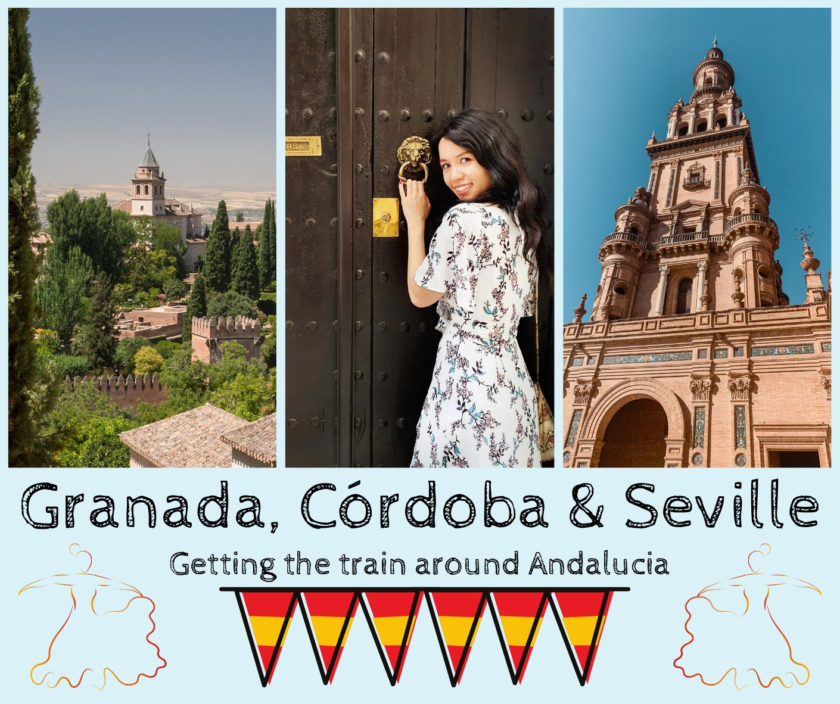
I feel incredibly lucky I that visited Andalucia before the world’s borders closed and we were told to stay inside.
It’s a region in the south of Spain that serenades any visitor with a tide of magnificent architecture, natural beauty and sumptuous cuisine. I feel happier just thinking about it.
Travelling by train, this surprisingly simple and easy route explores three cities known together as the Golden Triangle of Andalucia: Granada, Córdoba and Seville.
Along this journey you’ll admire Gothic, Renaissance and Moorish architecture, including the iconic Alhambra palace. By day, explore each city by foot, and by night taste the region’s cultural and culinary offerings.
This route is good for you if…
You’re hankering to experience a blend of cultures, rich history, inspiring monuments, delicious food and fabulous weather. This route delivers that right from the get go until the very end.
It’s also worth noting that you can do this rail journey the opposite way around by starting in Seville and ending in Granada. The only reason I opted to begin in Granada was simply because the flight times were better and cheaper. Though in my opinion, I think Seville is the perfect place to end the trip since it’s larger and there’s a bit more to do and see.
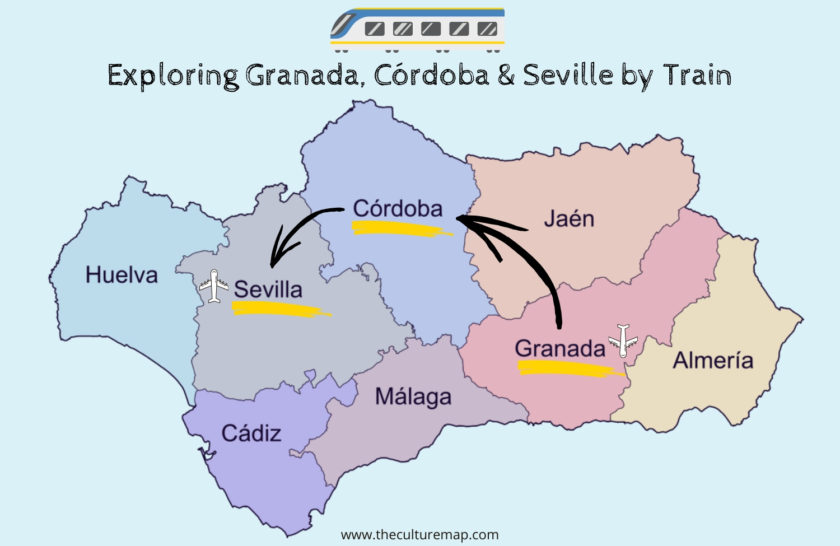
Break-down of train journeys
- Granada to Córdoba | Duration: 1h 40m | Cost: 25 Euros
- Córdoba to Seville | Duration: 1h 15m | Cost: 15 Euros
Booking train tickets
We booked our tickets from Granada to Córdoba through thetrainline.com before going because this leg of the journey was pricier. Though to be honest, I don’t think the price varies very much in Spain like it does in the UK so we didn’t save much by booking in advance.
However, if you’re travelling with someone and you want to sit together, I recommend booking in advance.
Since Córdoba and Seville are closer to each other the tickets weren’t too expensive. We didn’t want to be tied down to a specific time so decided to purchase a ticket on the day of travel. There was a fast train which takes appropriately 45 minutes, but at almost double the price so we opted for the slower train which still only took 1h 15m anyway.
Recommended length of nights in each city
Granada: 2 nights
Córdoba: 2 nights
Seville: 3 nights
A full week is a great length of time to see the highlights and soak up the vibe of each city.
If you don’t have a week to spare, then you could do: Granada x 2, Córdoba x 1, Seville x 2. You’ll still have time to fit in all the highlights and sample lots of tasty cuisine but you’ll have to skip the temptation of a lazy lie-in!
I absolutely fell in love with Córdoba, the only reason I’ve suggested less time there is because I’ve factored in your arrival and departure days at the airports – assuming you’re flying.
Granada
In the foothills of the spectacular Sierra Nevada, where almond orchards and pine trees coat the lower slopes, lies Granada. A city that has been strongly influenced by Moorish aesthetic, in fact the Moors ruled over Granada longer than any other kingdom in Spain – it was their last stronghold, and didn’t fall to the Christians until 1492.
The city is most famous for… the Alhambra
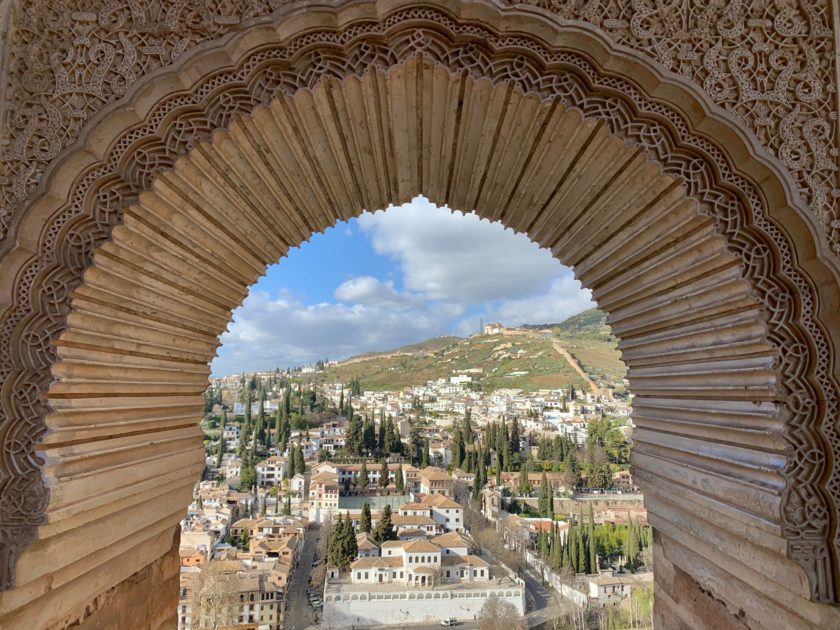
Granada is famous for playing host to a spectacular fortress, palace and gardens complex called The Alhambra. Completed in stages under various Muslim and Christian, it remains one of the best-preserved Moorish palaces in Spain, especially in the wake of restoration efforts. After climbing the hill and entering the site, you can explore the show-stopping complex for hours – the charming gardens, water features and various buildings, complete with exquisitely detailed plaster carvings and tileworks.
Other highlights of Granada
- Granada Cathedral is the one of largest and most visually spectacular cathedrals in Spain. Go inside and admire the ornate ceiling complete with huge Corinthian columns, delicate stained glass windows and the almost entirely white interior which give it the nickname ‘Cathedral of Light’.
Mercado San Agustin is an indoor food market situated just opposite the cathedral and houses a densely-packed cluster of stalls offering the freshest seafood, meat, fruit, vegetables and cheeses along with some of the finest quality olive oils and wines in the city. Ensure to stop by at lunchtime and grab a seat at Raw Material Restaurant for incredible seafood – the paella alone will make you wish you lived in Granada.
Mirador San Nicolás is the place for those classic sunset shots of the Alhambra sprawled along a wooded hilltop with the dark Sierra Nevada mountains looming in the background. It’s a well-known spot, accessible via Callejón de San Cecilio, so expect crowds during peak seasons.
Further reading → Is Granada the Most Beautiful City in Spain?
Where to eat: Book a reservation at El Mercader, if you haven’t booked, I still recommend checking to see if they have a table – you won’t be disappointed. A small family restaurant that brings together flavours of the region with a creative touch. You’ll experience great combinations and discover all sorts of incredible flavours.
Tours in Granada: Looking for a guided city tour or queue jump to the Alhambra? Take a look at what’s available to book in Granada.
Where to stay in Granada: I chose to stay at Hotel Casa 1800 Granada and I was happy with it. While not super modern, it is comfortable and places emphasis on character and charm to suit the architectural influences of the city. The hotel is also good value considering its close proximity to the Alhambra.
→ Search full list of hotels in Granada
Córdoba
Once the capital of the Islamic Empire in the west, with architectural treasures that have to be seen to be believed, Córdoba exceeded all my expectations. Furthermore, the vibe of the city is very different to Granada and Seville which by comparison feel European, whereas Córdoba feels more like Latin America with its cobbled alleyways and colourful buildings teamed with a gloriously relaxed atmosphere.
The city is most famous for… Cordoba Mosque Cathedral
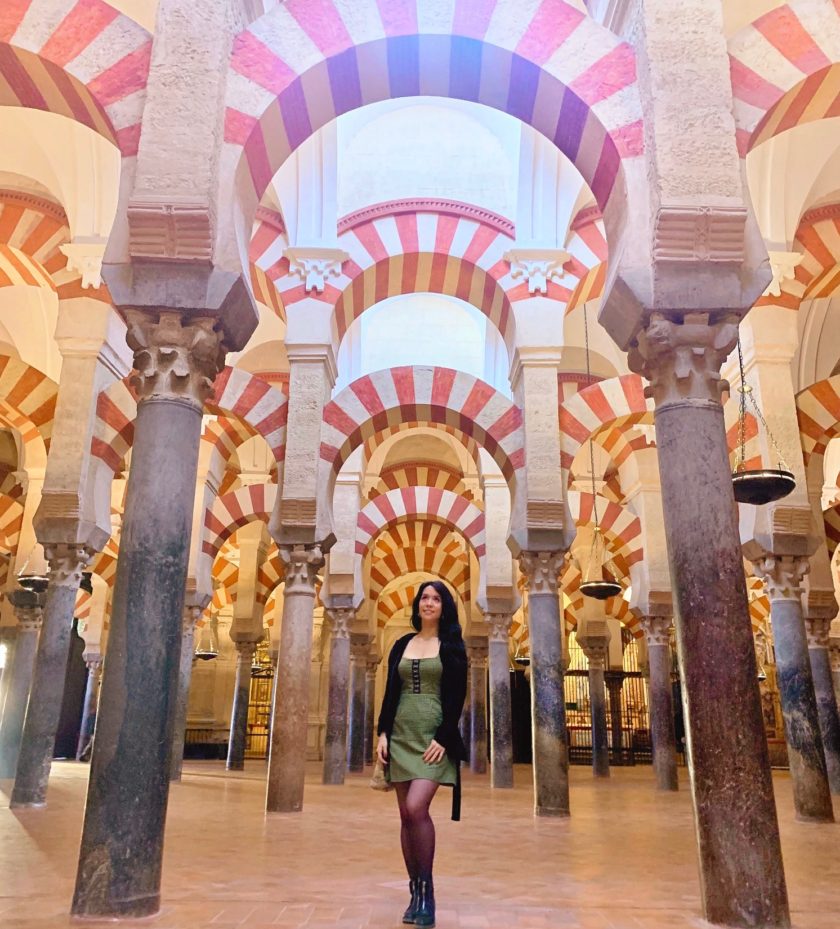
The crown jewel of the city is the Córdoba Mosque Cathedral, it’s not only architecturally inspiring but also a doorway into the city’s fascinating history.
After Córdoba was conquered by Muslims in the 700’s, the mosque was built atop a Visigoth church that previously existed at the site. Several hundred years later, after Córdoba’s reconquest by Spanish Catholics, the mosque was converted into a huge cathedral. I won’t lie, it’s an odd juxtaposition but still a fascinating combination of two architectural styles – featuring a vast array of columns and arches common to mosques, and higher roofs, chapels and glittery alter pieces more common to cathedrals. I’ve never seen anything like it.
Other highlights of Córdoba
- Alcázar de los Reyes Cristianos or the ‘Castle of the Christian Kings’ is where Fernando and Isabella lived in the castle for over eight years while they orchestrated the reconquest of Granada. It was also in the Alcazar that Christopher Columbus pitched his idea of looking for a Western route to reach India. Here you will find one of the most beautifully pruned gardens in Europe. Simply relax and admire the stunning work of a talented team of gardeners.
- Roman-era bridge spans the Guadalquivir river, and together with Puerta del Puente (Gate of the Bridge) and the Calahorra tower it has been declared a Site of Cultural Interest. In addition, it belongs to the historic centre of Córdoba which has been declared a World Heritage Site.
- Stroll around and take in one of the largest historical centres in Europe with Roman, Arabic and Christian structures side by side. Picturesque narrow lanes, the famous patios of Córdoba and small beautiful squares are to be seen everywhere.
Want a quick bite to eat? Head to Mercado Victoria located inside Jardines de la Agricultura. There’s a variety of stalls serving up top-notch food. I made a bee-line to O Pulpino and had a plate of delicious polio with mash Galicia style – meaning it’s flavoured with paprika. Yummy and very affordable!
Tours in Córdoba: Looking for theatre tickets, queue jumps or a grand tour of the city? Take a look at what’s available to book in Córdoba.
Where to stay in Córdoba I stayed at Balcon de Cordoba and it was the best placed I stayed during my trip to Andalusia. Located down a narrow street just a stone’s throw of the Mezquita-Catedral, this boutique hotel has lots of character. My room had a beautiful Juliet balcony overlooking the old city and views of the hotel’s lovely courtyard below.
It’s a boutique hotel, and as such, a little pricier than the other hotels I stay in, but the attention to detail in every aspect makes a stay here beyond memorable. If you book in advance you can have dinner serviced from the rooftop terrace which I definitely recommend.
→ Search all hotels in Cordoba
Seville
The capital of Andalucia, one of the most important cities in Spain and its fourth largest with a population of almost two million people, Seville has everything you could wish a big city to offer but with a surprisingly local feel.
The city is most famous for… the Real Alcazar
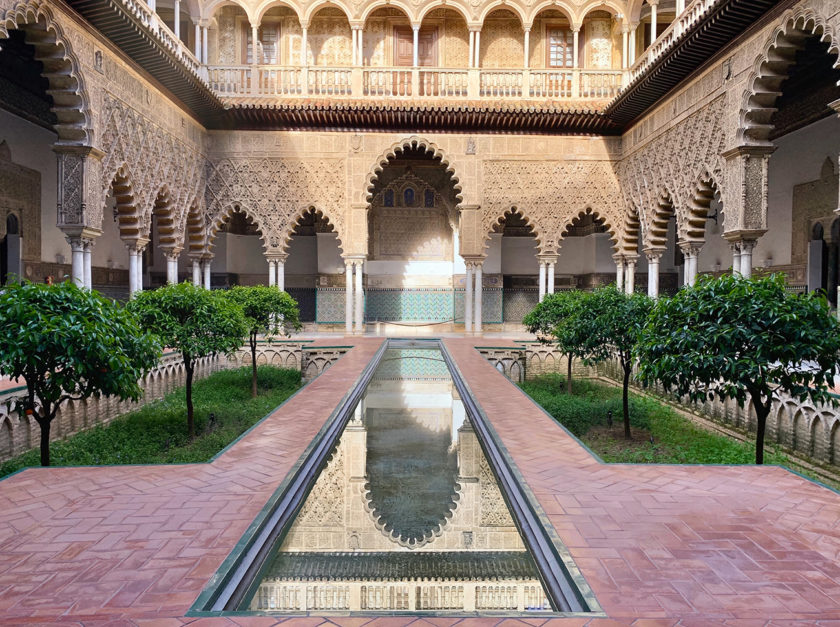
Ahhh it’s tough to pick one because the city spoils you with exquisite attractions on almost every corner, but push come to shove, I’d say the Real Alcazar. It was modelled on the Alhambra in Granada but is better preserved because the palace is still in use today. Trivia alert: some of you might recognise it as a film setting for Game of Thrones.
Other highlights of Seville
- Plaza de Espana commands attentions with its dreamy medley of architectural styles, incredible tile work and ornate bridges within a picturesque park setting. We watched a display of flamenco dancing and you can also rent a boat which made the place feel reminiscent of Venice – only much cheaper. I think this place was my favourite attraction in the whole of Seville, don’t miss it. It’s easily one of the most beautiful main squares in Europe.
- Seville Cathedral is an extraordinary (and enormous) building that serves as a bricks and mortar history lesson. The star attraction – the Giralda bell tower – was the minaret of what was the Great Mosque when southern Spain was under Moorish rule.
- Metropol Parasol is a unique chance to see contemporary architecture by Jürgen Hermann Mayer, the poster boy of outlandish designs. It’s huge, reportedly the largest wooden structure in the world. It’s nicknamed the mushroom but I think it looks more like a honeycomb but I’ll let you decide. It stays open late so it’s an easy attraction to squeeze in for nice views of city.
- Watch Flamenco to experience the style of dance so important to Spanish culture that it was named a UNESCO Intangible Cultural Heritage. There’s a good chance you might see dancing in some plazas but for an intimate experience book a show at Casa de la Guitarra, ‘the house of guitar’.
Tours in Seville: Looking for tickets to a flamenco show, queue jumps or a grand tour of the Real Alcazar? Take a look at what’s available to book in Seville.
Where to stay in Seville: I stayed 2 nights at Alcoba del Rey in the neighbourhood of Macarena. It is situated next door to the Basilica Macarena and about 20 minutes’ walk from the Real Alcazar. The thing that makes this small hotel stand out is its moorish design and decor that is reminiscent of staying in a riad in Morocco. Note that if you prefer to have most of the main highlights within very close walking distance, you might prefer to stay in accommodation located within the heart of the city.
→ Search all hotels in Seville
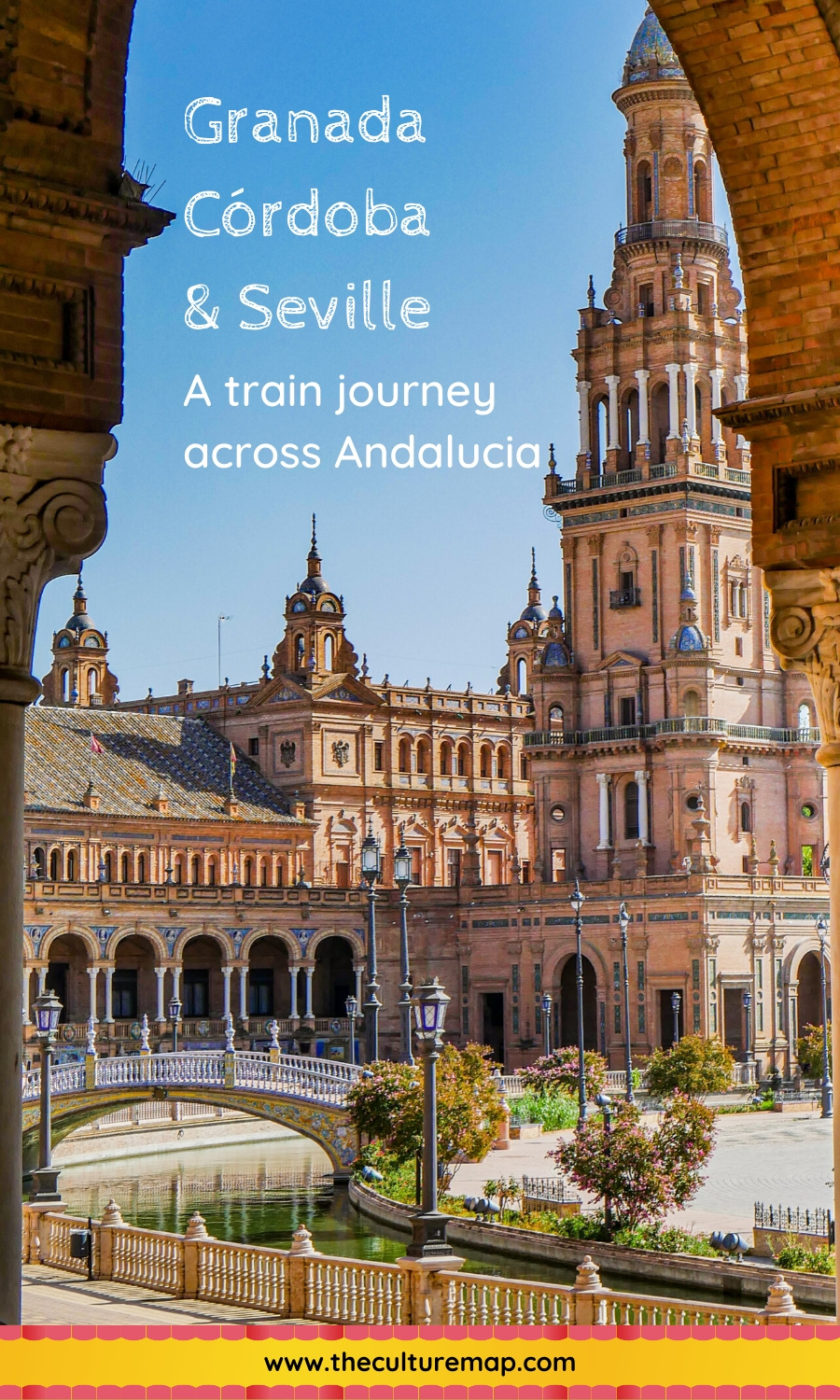


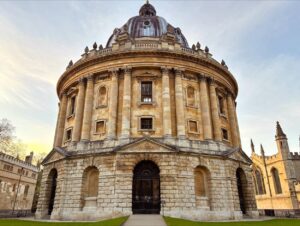

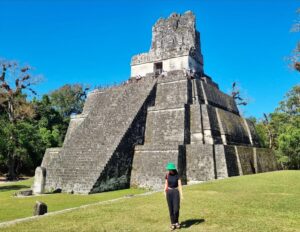
3 Responses
We are thinking of exactly the trip described, in December this year, to celebrate our Golden wedding. My question is about the having to move between the location with suitcases, do Spanish railways have luggage spaces on the trains? Before covid we travelled in Japan on trains and fortunately they have a system whereby you luggage can be transported between hotels and be at the next one upon your arrival, I don,t suppose such a system is available in Spain?
Regards
Terry Pearce
Do you have any recommendations for hotels in Cordoba and Seville, similar to Hotel 1800 in Granada?
Hi, I’m sorry for only getting back to you now. If it’s not too late, I have updated the post to include hotel information for Seville and Cordoba. I hope you have/had a wonderful time exploring Andalucia!